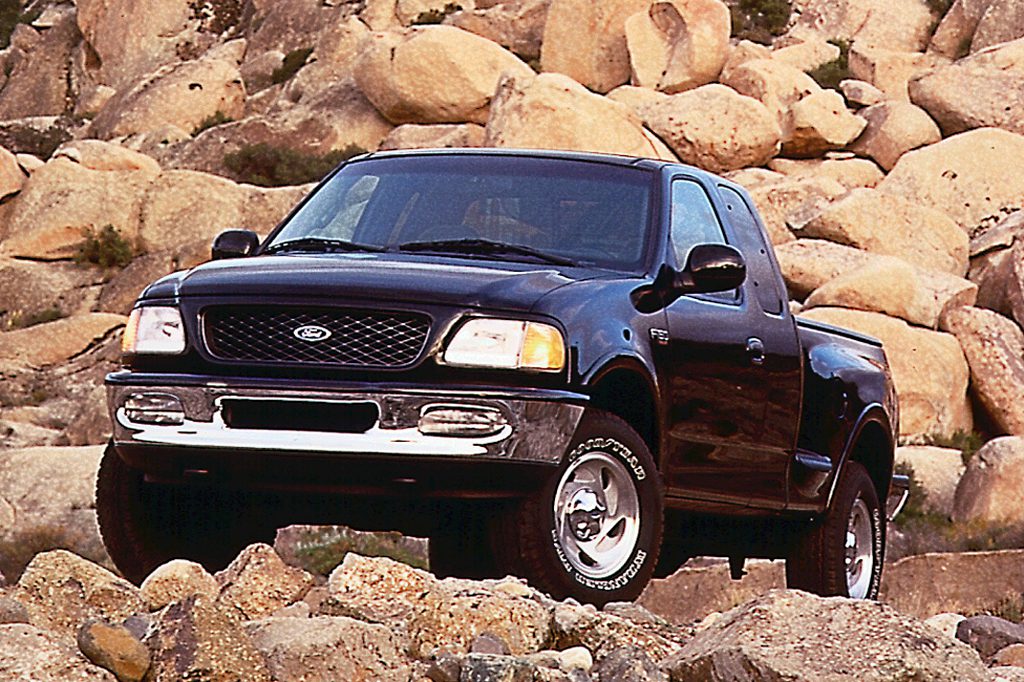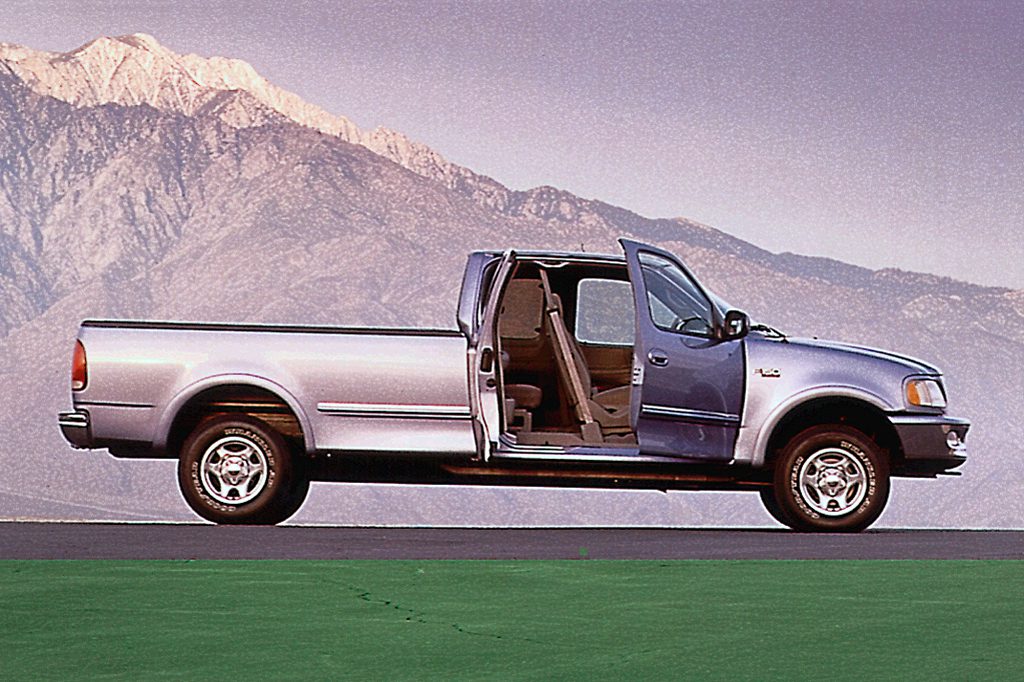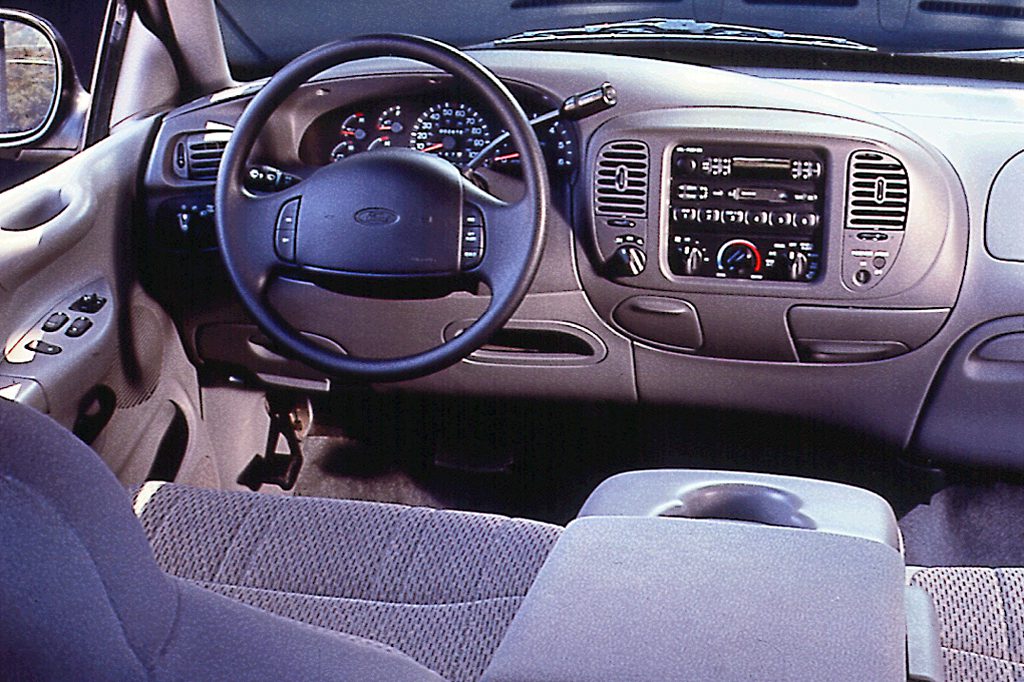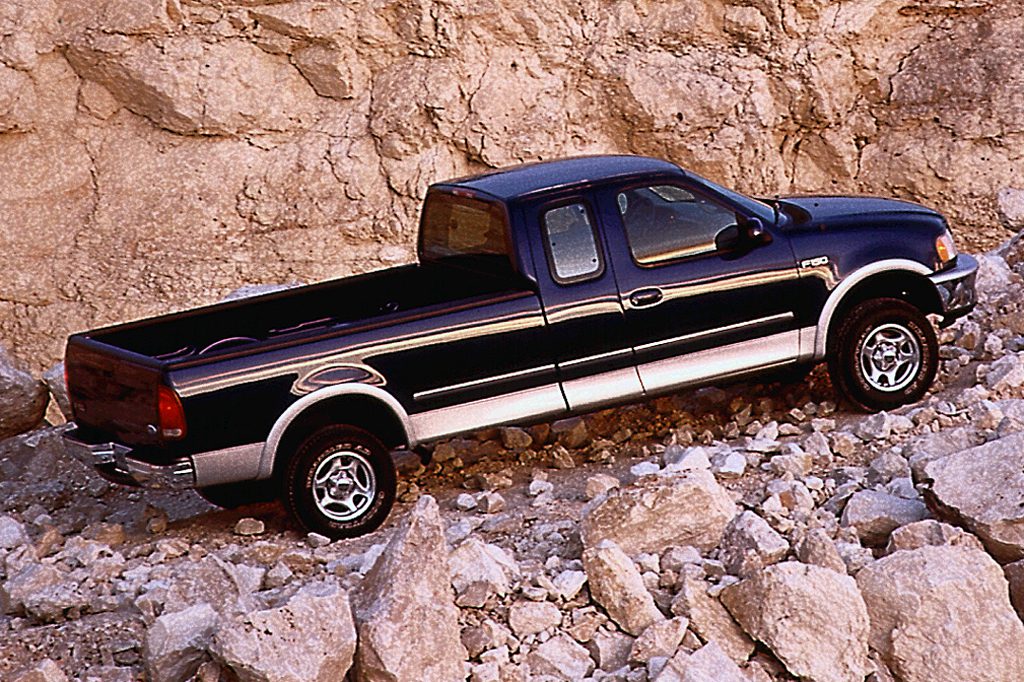| 2003 Ford F-150 |
Pricing Effective: 05/14/2003 |
| Model Pricing |
Retail Price |
Dealer Price |
Destination |
| XL Styleside 2WD regular cab, short bed |
$ 19,125 |
$ 16,893 |
$ 795 |
| XL Styleside 2WD regular cab, long bed |
19,425 |
17,151 |
795 |
| XL Flareside 2WD regular cab, short bed |
19,970 |
17,619 |
795 |
| XLT Styleside 2WD regular cab, short bed |
21,795 |
19,189 |
795 |
| XLT Styleside 2WD regular cab, long bed |
22,095 |
19,447 |
795 |
| XLT Flareside 2WD regular cab, short bed |
22,640 |
19,915 |
795 |
| XL Styleside 4WD regular cab, short bed |
22,465 |
19,765 |
795 |
| XL Styleside 4WD regular cab, long bed |
22,765 |
20,023 |
795 |
| XL Flareside 4WD regular cab, short bed |
23,310 |
20,491 |
795 |
| XLT Styleside 4WD regular cab, short bed |
25,210 |
22,125 |
795 |
| XLT Styleside 4WD regular cab, long bed |
25,510 |
22,384 |
795 |
| XLT Flareside 4WD regular cab, short bed |
26,055 |
22,853 |
795 |
| XL Styleside 2WD SuperCab ext. cab, short bed |
21,775 |
19,171 |
795 |
| XL Styleside 2WD SuperCab ext. cab, long bed |
22,075 |
19,429 |
795 |
| XL Flareside 2WD SuperCab ext. cab, short bed |
22,620 |
19,899 |
795 |
| XLT Styleside 2WD SuperCab ext. cab, short bed |
24,640 |
21,635 |
795 |
| XLT Styleside 2WD SuperCab ext. cab, long bed |
24,940 |
21,893 |
795 |
| XLT Flareside 2WD SuperCab ext. cab, short bed |
25,485 |
21,363 |
795 |
| Lariat Styleside 2WD SuperCab ext. cab, short bed |
28,315 |
24,796 |
795 |
| Lariat Styleside 2WD SuperCab ext. cab, long bed |
28,615 |
25,054 |
795 |
| Lariat Flareside 2WD SuperCab ext. cab, short bed |
29,160 |
25,523 |
795 |
| XL Styleside 4WD SuperCab ext. cab, short bed |
25,640 |
22,495 |
795 |
| XL Styleside 4WD SuperCab ext. cab, long bed |
25,940 |
22,753 |
795 |
| XL Flareside 4WD SuperCab ext. cab, short bed |
26,485 |
23,223 |
795 |
| XLT Styleside 4WD SuperCab ext. cab, short bed |
28,455 |
24,917 |
795 |
| XLT Styleside 4WD SuperCab ext. cab, long bed |
28,755 |
25,175 |
795 |
| XLT Flareside 4WD SuperCab ext. cab, short bed |
29,300 |
25,643 |
795 |
| Lariat Styleside 4WD SuperCab ext. cab, short bed |
31,610 |
27,629 |
795 |
| Lariat Styleside 4WD SuperCab ext. cab, long bed |
31,910 |
27,887 |
795 |
| Lariat Flareside 4WD SuperCab ext. cab, short bed |
32,455 |
28,357 |
795 |
| XLT Styleside 2WD SuperCrew crew cab, short bed |
28,485 |
24,943 |
795 |
| Lariat Styleside 2WD SuperCrew crew cab, short bed |
30,680 |
26,829 |
795 |
| XLT Styleside 4WD SuperCrew crew cab, short bed |
31,700 |
27,707 |
795 |
| Lariat Styleside 4WD SuperCrew crew cab, short bed |
34,135 |
29,801 |
795 |
| Lightning Flareside 2WD regular cab, short bed |
32,515 |
28,733 |
795 |
| Harley-Davidson Styleside 2WD SuperCrew crew cab, short bed |
36,975 |
32,243 |
795 |
| Price Note: 2WD XL/XLT SuperCab long bed require 4.6-liter V8 engine. |
| Standard Equipment |
| XL : 4.2-liter V6 engine, 5-speed manual transmission, dual front airbags, antilock 4-wheel disc brakes, air conditioning, power steering, cloth upholstery, bench seat, cupholders, split folding rear seat (SuperCab), AM/FM/cassette, digital clock, rear-hinged rear doors (SuperCab), passenger-side visor mirror, map lights, black vinyl floor covering, intermittent wipers, cargo-box light, theft-deterrent system, chrome front and rear bumpers, 4-lead trailering harness, full-size spare, P235/70R16 tires, 4WD models add: 4-wheel drive, 2-speed transfer case, 4.6-liter V8 engine (SuperCab) |
| XLT regular cab and SuperCab add: tilt leather-wrapped steering wheel, cruise control, split bench seat w/manual lumbar adjustment, power mirrors, power windows, power door locks, remote keyless entry, AM/FM/CD player, tachometer, variable-intermittent wipers, overhead console, compass, outside-temperature indicator, visor mirrors, carpeting, floormats, rear privacy glass, swing-out rear quarter windows (SuperCab), tailgate locks, polished alloy wheels, 4WD models add: 4-wheel drive, 2-speed transfer case, 4.6-liter V8 engine (SuperCab), fog lights, front tow hooks |
| XLT SuperCrew adds: 4.6-liter V8 engine, 4-speed automatic transmission, power-adjustable pedals, front-hinged rear doors, split folding rear seat, P255/70R16 tires, 4WD models add: 4-wheel drive, 2-speed transfer case, fog lights, front tow hooks, P255/70R16 white-letter tires |
| Lariat adds to XLT regular cab and SuperCab: 4.6-liter V8 engine, 4-speed automatic transmission, automatic climate control, leather upholstery, 6-way power driver seat, power-adjustable pedals, keypad entry, AM/FM/cassette/CD player, automatic day/night rearview mirror, universal garage-door opener, digital memo recorder, illuminated visor mirrors, rear defogger, front-hinged rear doors (SuperCrew), automatic headlights, outside-mirror-mounted turn signals, P275/60R17 white-letter tires, chrome steel wheels, 4WD models add: 4-wheel drive, 2-speed transfer case, front tow hooks, fog lights, P265/70R17 all-terrain white-letter tires |
| Lightning adds to XLT regular cab: 5.4-liter supercharged V8 380-horsepower engine, 4-speed automatic transmission, limited-slip differential, cloth/leather upholstery, 6-way power driver seat, heated power mirrors w/turn signals, keypad entry, AM/FM radio w/in-dash 6-disc CD changer, automatic headlights, sliding rear window, fog lights, color-keyed bumpers, Class III trailer hitch, 7-pin trailer-wiring harness, sport suspension, P295/45ZR18 tires, alloy wheels |
| Harley-Davidson Edition adds to Lariat: 5.4-liter supercharged V8 340-horsepower engine, limited-slip differential, quad captain chairs, front and rear consoles, AM/FM radio w/in-dash 6-disc CD changer, unique interior trim, tubular side bars, fog lights, bed mat, unique exterior trim, P275/45VR20 tires, chrome alloy wheels |
| Optional Equipment |
| Option Note: |
| Major Packages |
| Option |
Avail. |
Retail |
Dealer |
| STX Edition |
XL, XLT regular cab/SuperCab |
$995 |
$846 |
| Cloth split bench seat, AM/FM/CD/MP3 player, color-keyed exterior trim, unique grille, chrome tubular step bars, fog lights, P275/60R17 white-letter tires (2WD), P265/70R17 all-terrain white-letter tire (4WD), chrome steel wheels. NA w/Sport Group, Off-Road Equipment Group. |
| XL Sport Group |
2WD XL short bed |
495 |
421 |
| Mfr. Disc. |
|
295 |
251 |
| XL Sport Group |
4WD XL short bed |
595 |
506 |
| Mfr. Disc. |
|
400 |
340 |
| Split bench seat, leather-wrapped steering wheel (w/Convenience Group), tachometer (4WD), color-keyed bumpers and mirrors, fog lights (4WD), special axle ratio, front tow hooks (4WD), decals, P255/70R16 white-letter tires, polished alloy wheels. NA w/V8 engines, Work Truck Group, STX Edition. |
| B3N XL V6 Special Value Group |
XL |
495 |
421 |
| Mfr. Disc. |
|
295 |
251 |
| P255/70R16 white-letter tires, alloy wheels. NA w/V8 engines. |
| Work Truck Group |
XL Styleside (credit) |
-1205 |
-1024 |
| Argent grille and bumpers, vinyl seat. Deletes air conditioning. NA with carpeting, Convenience Group, Sport Group, STX Edition, AM/FM/CD player, Cab Steps, fog lights. |
| XL Convenience Group |
XL |
350 |
298 |
| Tilt steering wheel, cruise control, overhead console, tailgate locks. NA w/Work Truck Group. |
| Heritage Edition |
XLT SuperCab Styleside short bed |
1200 |
1020 |
| Unique exterior and interior trim, center console, 2-tone paint, chrome tubular step bars, bedliner, fog lights, P275/60R17 white-letter tires (2WD), P265/70R17 all-terrain white-letter tires (4WD), special alloy wheels. |
| XLT Sport Group |
XLT short bed |
595 |
506 |
| Color-keyed bumpers and grille, color-keyed mirrors, split sport seat, special axle ratio, cast alloy wheels, P275/60R17 white-letter tires (2WD), P265/70R17 all-terrain white-letter tires (4WD). NA w/FX4 Off-Road Equipment Group, SuperCrew. 4WD w/4.2-liter V6 engine requires manual transmission. |
| XLT Special Value Group w/CD changer |
2WD XLT regular cab/SuperCab |
590 |
502 |
| Mfr. Disc. |
|
295 |
251 |
| XLT Special Value Group w/CD changer |
4WD XLT regular cab/SuperCab |
695 |
591 |
| Mfr. Disc. |
|
400 |
340 |
| AM/FM radio w/in-dash 6-disc CD changer, P255/70R16 white-letter tires. NA w/V8 engines. |
| XLT Special Value Group w/captain chairs |
2WD XLT regular cab/SuperCab |
785 |
668 |
| Mfr. Disc. |
|
295 |
251 |
| XLT Special Value Group w/captain chairs |
2WD XLT regular cab/SuperCab |
890 |
757 |
| Mfr. Disc. |
|
400 |
340 |
| Captain chairs, P255/70R16 white-letter tires. NA w/V8 engines. |
| FX4 Off-Road Equipment Group |
4WD XLT regular cab/SuperCab |
1405 |
1194 |
| FX4 Off-Road Equipment Group |
4WD XLT SuperCrew |
1205 |
1024 |
| FX4 Off-Road Equipment Group |
4WD Lariat |
860 |
731 |
| Unique body cladding, decals, 3.55 limited-slip differential, heavy-duty shock absorbers, skid plates, P265/70R17 all-terrain white-letter tires, cast alloy wheels. Requires V8 engine. NA w/STX Edition. |
| Top Three Accessories Pkg. |
|
750 |
638 |
| Color-keyed running boards, bedliner, wraparound hood deflector. NA Lightning, long bed, SuperCrew. |
| Payload Pkg. 2 |
2WD XL/XLT regular cab |
270 |
229 |
| Heavy-duty springs and shock absorbers, 3.55 axle ratio, P255/70R16 tires. Requires 4.2-liter V6 engine. |
| Payload Pkg. 3 |
2WD XL/XLT regular cab long bed |
270 |
229 |
| Payload Pkg. 3 |
2WD XL/XLT regular cab long bed w/Work Truck Group |
470 |
399 |
| Heavy-duty springs and shock absorbers, 3.55 axle ratio, P255/75R16SL tires. Requires 4.6-liter V8 engine and automatic transmission. |
| 627 Payload Pkg. A |
2WD long bed regular cab/SuperCab, short bed SuperCab |
1295 |
1101 |
| Includes larger brakes, heavy-duty frame and suspension, Heavy-Duty Electrical/Cooling Pkg., LT245/75R16D tires (2WD), LT245/75R16D tires all-terrain white-letter tires (4WD), chrome steel wheels (XLT). NA Flareside or with Sport Group. Requires 5.4-liter engine and automatic transmission. |
| 628 Payload Pkg. B. |
2WD long bed regular cab, 2WD short bed SuperCab |
1430 |
1216 |
| Class III Trailer Towing Group, 4.10 limited-slip rear differential, transmission oil cooling, LT245/75R16D tires, chrome steel wheels. NA Flareside or with Sport Group. Requires 5.4-liter engine and automatic transmission. |
| Class III Trailer Towing Group |
|
350 |
298 |
| Heavy-Duty Electrical/Cooling Pkg., 7-wire trailer harness, trailer hitch, heavy-duty shock absorbers. Std. Lightning. |
| Powertrain |
| Option |
Avail. |
Retail |
Dealer |
| 4.2-liter V6 engine |
XL |
0 |
0 |
| Mfr. Disc. |
(credit) |
-250 |
-213 |
| Discount requires Work Truck Group. |
| 4.6-liter V8 engine |
XL/XLT regular cab, 2WD XL/XLT SuperCab |
750 |
638 |
| Std. 4WD SuperCab. |
| 5.4-liter V8 engine |
XL/XLT regular cab, 2WD XL/XLT SuperCab |
1550 |
1318 |
| 5.4-liter V8 engine |
Lariat, 4WD SuperCab, SuperCrew |
800 |
680 |
| Requires automatic transmission. |
| 5-speed manual transmission |
XL, XLT regular/SuperCab |
0 |
0 |
| Mfr. Disc. |
(credit) |
-500 |
-425 |
| Requires 4.2-liter or 4.6-liter engine. Discount requires air conditioning. |
| 4-speed automatic transmission |
XL, XLT |
1095 |
931 |
| Std. XLT SuperCrew. |
| Electronic transfer case |
4WD XLT/Lariat |
160 |
136 |
| Requires 4.6-liter or 5.4-liter engine and 4-speed automatic transmission. Std. SuperCrew. |
| Optional rear axle ratio |
|
50 |
43 |
| Limited-slip differential |
|
285 |
243 |
| Std. Lightning, Harley-Davidson. |
| Comfort & Convenience Features |
| Option |
Avail. |
Retail |
Dealer |
| Air conditioning |
XL |
850 |
723 |
| Requires Work Truck Group. |
| Rear-seat entertainment system |
SuperCrew |
1295 |
1101 |
| Videocassette player, LCD screen, headphones, remote control. NA Harley-Davidson. NA w/power sunroof. |
| Power sunroof |
XLT/Lariat SuperCab, SuperCrew |
810 |
688 |
| Cruise control and tilt steering wheel |
XL |
385 |
328 |
| NA w/cloth split bench seat. |
| Power-adjustable pedals |
XL, XLT regular cab/SuperCab |
120 |
102 |
| Requires automatic transmission. |
| Cloth split bench seat |
XL |
400 |
340 |
| Captain chairs |
XLT, Lariat |
490 |
417 |
| Includes floor console. |
| Power driver seat |
XLT |
360 |
306 |
| Includes automatic headlights. Requires automatic transmission when ordered with captain chairs. |
| Heated front seats |
XLT, Lariat, Harley-Davidson |
245 |
208 |
| XLT requires power driver seat. |
| AM/FM/CD player |
XL |
190 |
162 |
| AM/FM/cassette/CD player |
XL |
315 |
267 |
| AM/FM/cassette/CD player |
XLT |
125 |
107 |
| AM/FM/cassette w/6-disc CD changer |
XLT, Lariat |
295 |
251 |
| Power sliding rear window |
Lariat, Harley-Davidson |
245 |
208 |
| Deletes rear defogger. |
| Carpeting |
XL |
145 |
123 |
| Includes floormats. |
| Appearance and Miscellaneous |
| Option |
Avail. |
Retail |
Dealer |
| Sliding rear window |
XL/XLT regular cab/SuperCab |
125 |
107 |
| 2-tone paint |
XLT, Lariat |
225 |
192 |
| NA XLT w/FX4 Off-Road Equipment Group or Flareside. Std. King Ranch. |
| Cab steps |
Flareside, 4WD regular cab/SuperCab |
350 |
298 |
| Cab steps |
2WD Styleside, SuperCrew |
250 |
213 |
| NA Lightning, Harley-Davidson. |
| Chrome tubular step bars |
XLT, Lariat |
400 |
340 |
| Chrome tubular step bars |
XLT w/Top Three Accessories Pkg. |
75 |
64 |
| Fog lights |
XL 4WD |
140 |
119 |
| Requires front tow hooks. |
| Bedliner |
Lightning |
295 |
251 |
| Bed extender |
SuperCrew |
195 |
166 |
| Tonneau cover |
Lightning |
150 |
128 |
| Engine-block heater |
|
0 |
0 |
| Includes heavy-duty battery. Available in Alaska, Minn., Mont., N.D., S.D., Wis., Wyo. |
| Special Purpose, Wheels and Tires |
| Option |
Avail. |
Retail |
Dealer |
| Skid plates |
4WD SuperCab/SuperCrew, 4WD regular cab long bed |
160 |
136 |
| Skid plates |
4WD regular cab short bed |
80 |
68 |
| Front tow hooks |
4WD XL |
40 |
34 |
| Requires fog lights. |
| Alloy wheels |
XL |
200 |
174 |
| NA w/Work Truck Group. |
| P235/70R16 white letter tires |
XL, XLT |
125 |
107 |
| NA SuperCrew. |
| LT245/75R16 all-terrain white-letter tires |
4WD XL,4WD XLT |
695 |
591 |
| P255/70R16SL white-letter tires |
XLT regular cab/SuperCab |
295 |
251 |
| P255/70R16 all-terrain white-letter tires |
regular cab/SuperCab |
125 |
107 |
| P255/70R16 all-terrain white-letter tires |
4WD XL |
400 |
340 |
| Requires Sport Group. |
| P265/70R17 white-letter tires |
4WD XLT SuperCrew |
340 |
289 |
| LT265/70R17 all-terrain white-letter tires |
4WD XLT |
300 |
255 |
| Requires FX4 Off-Road Equipment Group or STX Pkg. |





